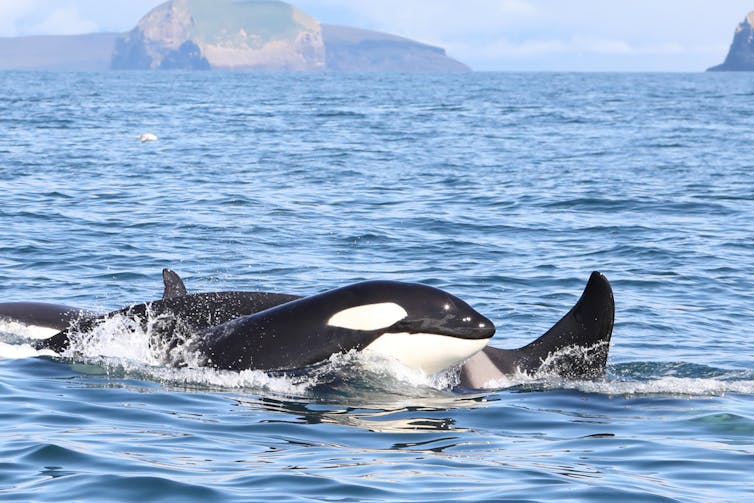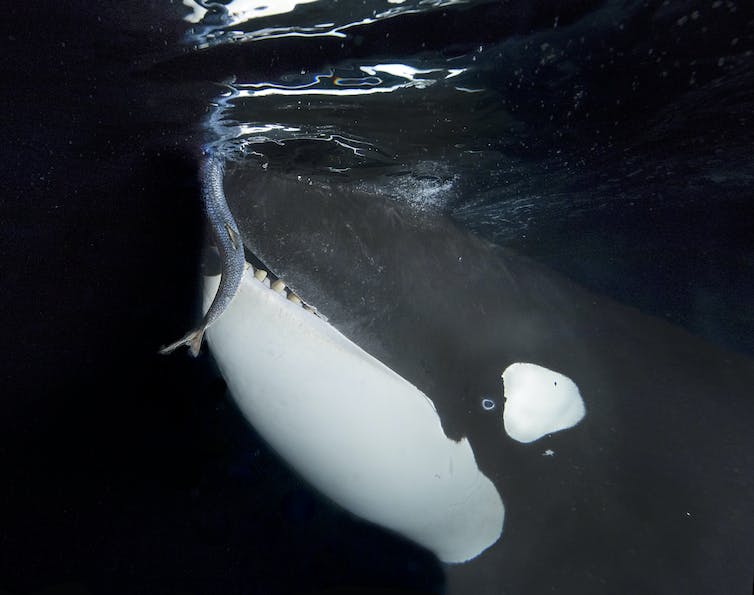Killer whales, also called orcas, are known for their intelligence and striking presence. They are also enduring a silent but persistent threat beneath the surface of our oceans.
My research investigates killer whales and their diets in the North Atlantic. Previous studies have focused on killer whales in the Pacific Ocean. But until now, no data existed for our killer whales in the North Atlantic, including those in Eastern Canada and the Canadian Arctic.
With other international researchers, I recently published a study in Environmental Science & Technology that reveals a troubling reality: these apex predators are carrying high levels of persistent organic pollutants (POPs) in their blubber. The accumulation of these synthetic contaminants is also creating health risks for the killer whales.
Forever chemicals
POPs are also known as “forever chemicals” due to their remarkable stability and long-lasting nature. This group includes well-known compounds like polychlorinated biphenyls (PCBs), chlorinated pesticides like dichlorodiphenyltrichloroethane (DDT) and brominated flame retardants.
In the last century, these chemicals were mass produced and used in a wide range of applications, such as industrial processes or agriculture. But research conducted in Sweden in the late 1960s revealed that these chemicals accumulate in living organisms and persist in the environment.
The chemicals bind to fats and increase in concentration as they move up the food web, impacting dolphins and whales the most. These animals, being top predators, accumulate the largest concentrations and struggle to eliminate these chemicals. This buildup of contaminants through their diets — known as biomagnification — is especially concerning for marine mammals, as they need ample fat for warmth and energy.
At high concentrations, these chemicals disrupt the mammals’ immune and hormonal systems but also affect their ability to reproduce, and can even lead to cancer.
(Audun Rikardsen), Author provided (no reuse)
A gradient of contamination
Our study, focusing on 160 killer whales, reveals a concerning pattern of PCB contamination accross the North Atlantic. The concentrations vary significantly across the North Atlantic, ranging from a staggering 100 mg/kg in the Western North Atlantic, to around 50 mg/kg in the mid-North Atlantic. Intriguingly, killer whales in the Eastern North Atlantic carry lower PCB levels at roughly 10 mg/kg in Norway.
For context, PCB-related immune effects start at 10mg/kg, while reproductive failure was observed at 41 mg/kg in marine mammals. Killer whales in Eastern Canada and the Canadian Arctic have PCB levels exceeding twice the threshold linked to reproductive problems in marine mammals.
You are what you eat
Diet plays a pivotal role in this pattern of contamination. Killer whales that primarily feed on fish tend to have lower contaminant levels. On the other hand, those with diets focused on marine mammals, particularly seals and toothed whales, show higher levels of contaminants.
Killer whales with mixed diets — containing both fish and marine mammals — tend to display elevated contaminant levels, particularly in Iceland.
Our research investigates the potential impact of diet preferences on killer whale health. Risk assessments suggest that killer whales in the Western North Atlantic, and specific areas of the Eastern North Atlantic where they have mixed diets, face higher risks, directly linked to what they eat.
Among the emerging contaminants, hexabromocyclododecane (HBCDD), a flame retardant, is of particular concern. Concentrations of HBCDD in North Atlantic killer whales are among the highest measured in any marine mammals, surpassing levels found in their North Pacific counterparts.
Disappearing sea ice
This reveals the fascinating complexity of killer whale ecology and underscores how their dietary choices significantly impact their exposure to environmental pollutants.
It also raises some concern for “Arctic-invading” killer whales that progressively move north due to climate change. Killer whales’ large dorsal fin has traditionally prevented them from navigating dense sea ice. But the melting of sea ice has allowed killer whales to access a new habitat with new prey species.
There, researchers believe that they will hunt more and more marine mammals, like ringed seals, narwhals and belugas. These dietary shifts, influenced by our changing environment, may result in heightened health risks for apex predators.
Read more:
Analyzing the fat of killer whales reveals what they eat
Maternal transfer means females are less contaminated
The study also spotlights a sex difference in contaminant concentrations. Male killer whales appear to be more contaminated than their female counterparts, thanks to the transfer of contaminants from adult females to their offspring during gestation and lactation.
Killer whale mothers use their own energy to produce fatty milk for their calves, helping them grow quickly and stay healthy. This nutritious milk comes from the mother’s blubber, where contaminants are stored. As she feeds her young ones, she may pass on as much as 70 per cent of these stored contaminants.

(Anaïs Remili), Author provided (no reuse)
Urgent action
In response to these findings, urgent action is needed to protect North Atlantic killer whales and their ecosystems. The 2001 United Nations treaty’s objective to phase out and destroy PCBs by 2028 is slipping out of reach.
Substantial quantities of PCB-contaminated waste are stored in deteriorating warehouses, risking contaminants ending up in the environment, and further affecting our ecosystems. To compound the issue, as one chemical gets banned, another often emerges, with enough variations to avoid previous regulations, perpetuating a harmful cycle.
To effectively tackle the issue of contaminant accumulation in killer whales, the following actions are necessary:
- Urgent steps are needed for the proper disposal of PCB-contaminated waste, with an emphasis on international collaboration to support nations lacking the infrastructure for waste management.
- It is crucial to prevent the release of potentially more harmful contaminants into the environment by improving toxicity testing of chemicals before they enter the market.
- Collaboration among ecotoxicologists, conservation biologists, policymakers and other stakeholders is essential. Effective strategies to mitigate pollution’s adverse effects can only be developed through collective efforts.
- Targeted conservation efforts should be directed toward populations at higher risk, such as killer whales in the Eastern Canadian Arctic, and Eastern Canada.
Chemical pollution has been identified as one of the nine global threats to wildlife, as well as human health in modern times. It is time to give our planet — and killer whales — the relief they need by reducing existing contaminants through concrete actions.




